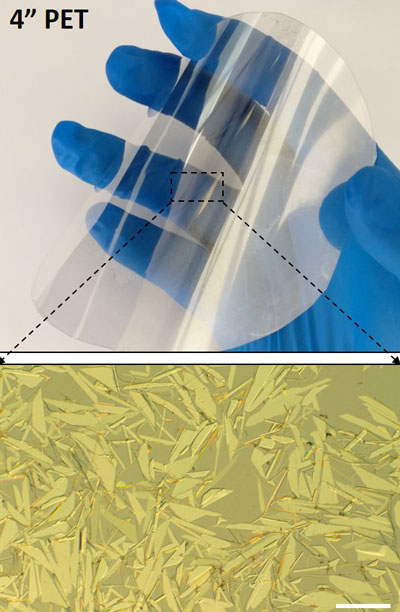| Posted: Jun 13, 2018 |
Field-effect transistors made from solution-grown 2D tellurene
(Nanowerk News) Purdue University researchers have discovered a two-dimensional nanomaterial derived from the rare element tellurium that may change how infrared technology is used in national defense tools, surveillance equipment, high-performance electronics and biochemical detection devices.
|
|
The researchers created the nanomaterial, which they called tellurene, in a solution. The material has a thin, durable structure with unique properties.
|
|
“We can build this material atom-by-atom and scale it up for many different uses,” said Wenzhuo Wu, an assistant professor in Purdue’s School of Industrial Engineering, who worked on the team that discovered tellurene. “Our material is superior to other two-dimensional materials such as black phosphorous because we have a high production yield and tellurene is air-stable. Tellurene can grow on its own without the help of another substance, which makes it different than those other materials.”
|
|
Tellurium is not abundant on the Earth’s crust, but Wu said only a tiny amount is needed to be synthesized through their solution method.
|
|
Tellurene has several potential applications, including high-speed electronics and infrared technology. Wu said tellurene is ideal to incorporate into surveillance equipment and devices used by the government and military for national security and defense, including airport scanners, night-vision devices, infrared sensors and high-speed transistors.
|
 |
| This graphic shows the large-scale transfer and assembly of tellurene on flexible PET substrates. (Image: Purdue University)
|
|
“Our discovery is a nanomaterial with a very large lateral surface but atomic-level thickness,” Wu said. “It has a very strong light absorption component. We can develop state-of-the-art, ultrathin transistor and infrared devices using tellurene.”
|
|
Wu recently collaborated with Professor Peide Ye’s group from Purdue’s School of Electrical and Computer Engineering and demonstrated high-performance transistors using the tellurene material synthesized in Wu’s group.
|
|
This work was recently published in Nature Electronics ("Field-effect transistors made from solution-grown two-dimensional tellurene"). Wu’s group is now working on the development of several tellurene based infrared technologies.
|
|
Wu said tellurene’s thin structure also makes it more affordable and flexible compared with current bulky electronic devices.
|
|
“This new discovery also has potential applications in the field of biochemical detection,” Wu said. “For instance, tellurene could be used as a key building component for biosensors in airports to detect if a passenger is infected with a communicable disease. The tellurene is very sensitive to temperature differences in the body, which can be good indicators of disease.”
|
|
A patent application has been filed by the Purdue Office of Technology Commercialization and the technology for producing tellurene is available for licensing.
|

